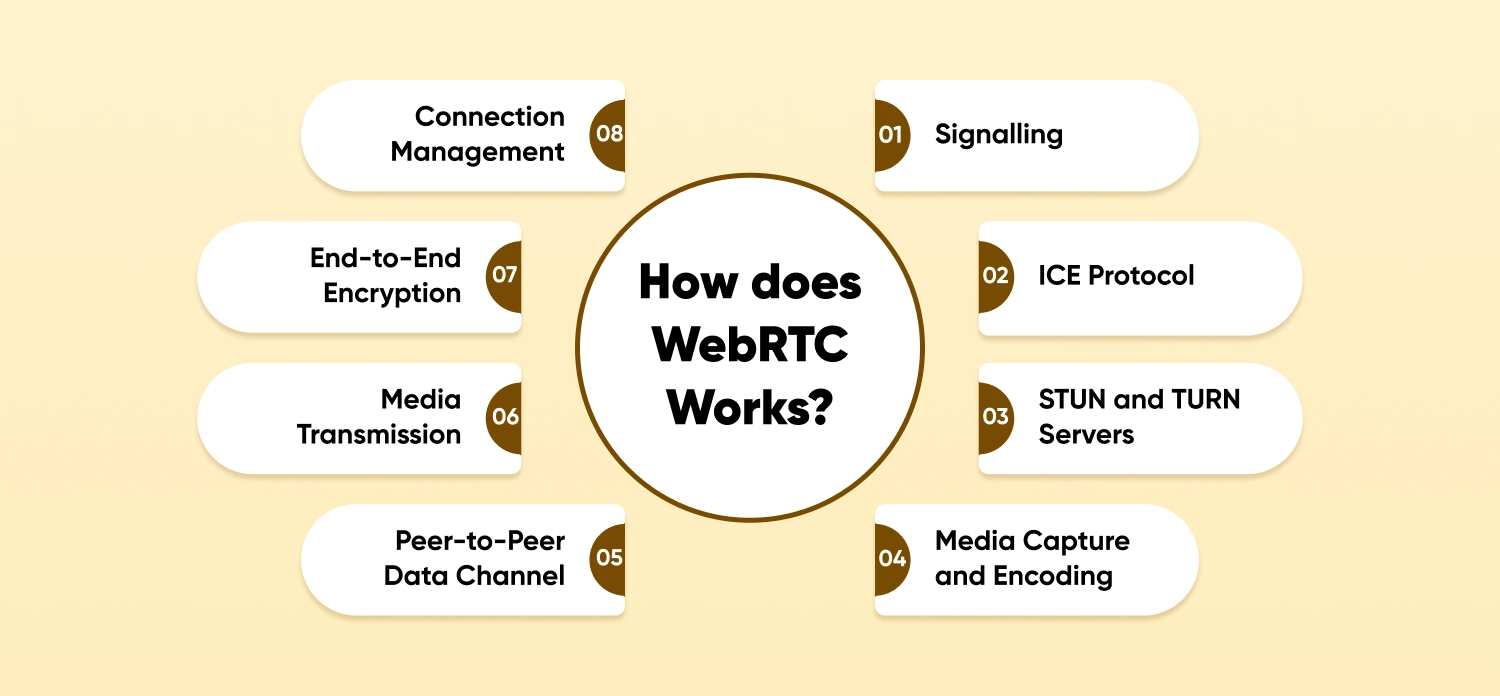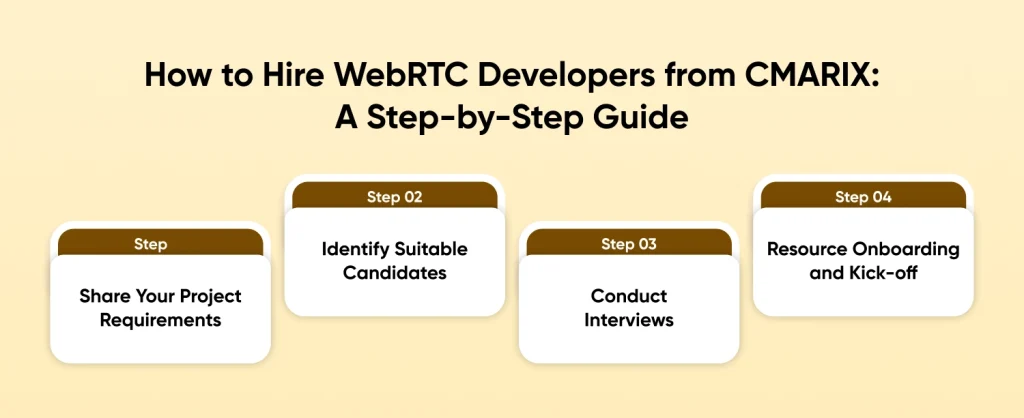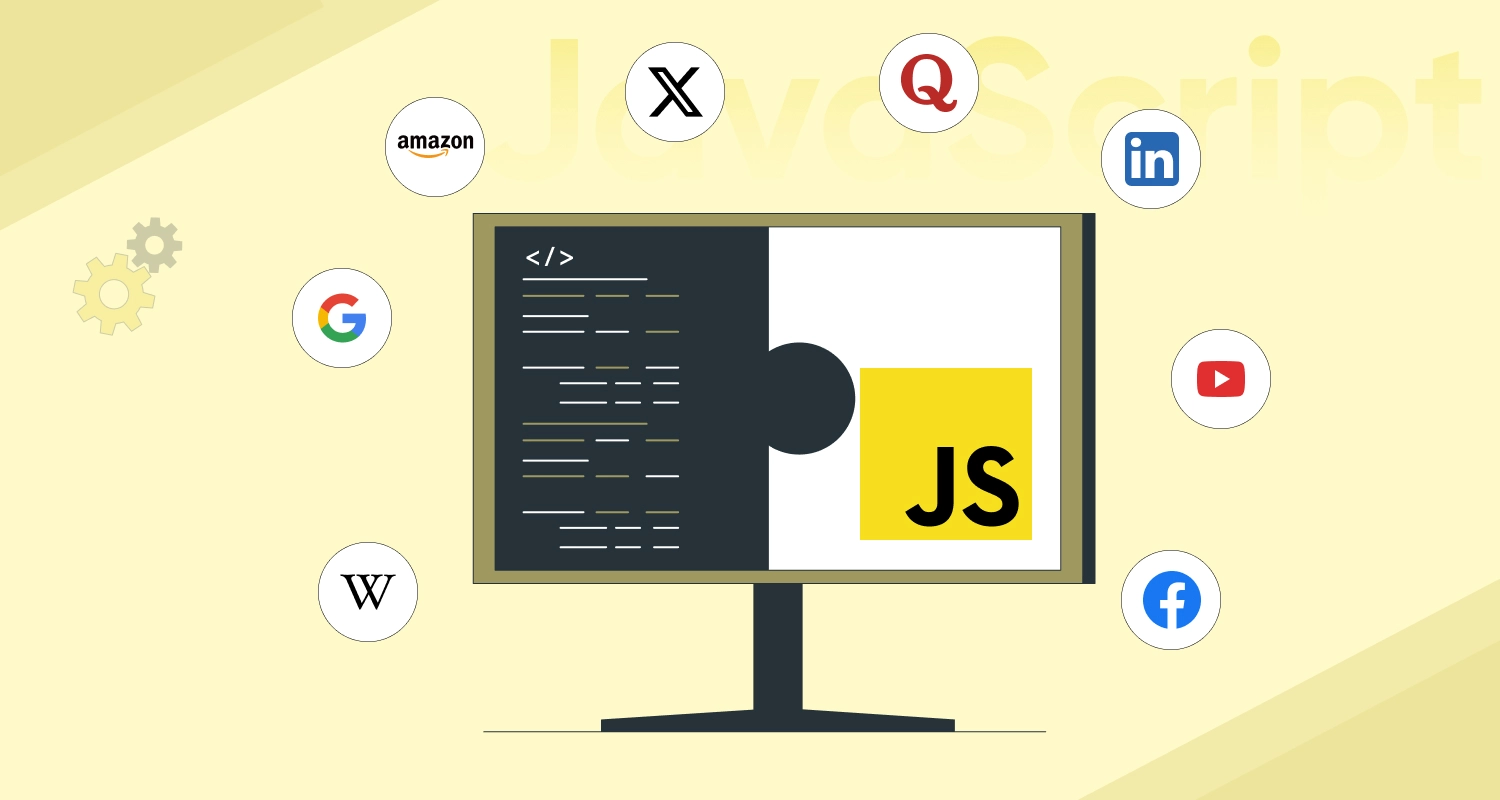It’s 2025 and the demand for real-time communication is not limited to sports or news channels or applications, it is a widespread necessity for multiple industries. Whether you want to implement active customer support chat systems or collaborative tools like video conferencing, you need a reliable, stable and secure platform to handle it all. For handling exactly these requirements, companies are turning to WebRTC – Web Real-Time Communication. As businesses are embracing digital transformation, it is becoming increasingly important to hire WebRTC developers that can build effective and long-lasting communication channels.
Today, this guide will help you understand and make strategic hiring choices when looking for WebRTC developers. We will discuss the key skills you should be looking for, the relevance of WebRTC in the future, when to look for WebRTC developers and how to hire dedicated WebRTC developers.
What is WebRTC?
WebRTC provides a one-stop solution for real-time communication needs like smart chatbot systems, video conferencing platforms and more. As more organizations embrace digital transformation, hiring the best WebRTC developers for the job becomes that much more important.
Key Features of WebRTC
Now that we know what WebRTC is, let’s dive a little deeper into its core features that make it an indispensable tool for the future of real-time communication:
Real-Time Audio, Video, and Data Sharing
Using WebRTC users can easily share audio, video and data in real-time. Whether it is for a video call, a telephonic conference or even transferring files during a live session, with proper WebRTC implementation, everything can be managed within a browser. This makes WebRTC ideal for customer support, collaborative tools and video conferencing.
Browser-Based Communication
WebRTC makes all processes a lot easier since it directly works with a browser. Users don’t have to download or install any plugins or applications. This simplifies the user experience and motivates more users to onboard.
Peer-to-Peer Connection
This allows users to connect directly with each other. It removes the need for managing and maintaining centralized servers for sharing media.
End-to-End Encryption
Real-time communication needs to come with the assurance of security, and WebRTC addresses this concern quite well. All audio, video and data exchanged between peers gets encrypted using secure protocols.
Cross-Platform Compatibility
We already discussed one of the biggest benefits of WebRTC being its ability to handle all these requests through browsers. WebRTC supports Firefox, Chrome, Safari and Edge. It also works well on mobile platforms like Android and iOS.
How Does WebRTC Works?

WebRTC provides direct P2P communication following some important steps. The process involves several components that work together for establishing and maintaining a secure and real-time connection.
1. Signaling
The process starts with signaling, which is exchanging information between peers for establishing a connection. This includes media formats, network information and session control. Signaling doesn’t get defined by WebRTC, here you need to hire WebRTC developers using protocols like WebSocket, HTTP or others for establishing effective signals. Once signaling information is shared, peers can go to the next step.
2. ICE Protocol (Interactive Connectivity Establishment)
Moving on, the ICE protocol helps find the best path between the peers. It gathers information like IP addresses and ports from each peer and tries to find the most efficient connection method to connect the two.
3. STUN and TURN Servers
WebRTC uses these two technologies to help peers build a connection behind NATs/firewalls. STUN servers provide a public IP address and port of the client whereas TURN servers relay data when direct P2P connections aren’t possible.
4. Media Capture and Encoding
Media capture includes audio and video streams using browser’s in-built APIs like getUserMedia. These media streams then get encoded before being sent to other peers.
5. Peer-to-Peer Data Channel
You can also use WebRTC for establishing data channels that allow real-time data transmission between peers. This can be used for file sharing, text messaging and other data services without affecting the audio/video stream.
6. Media Transmission
The audio, data and video streams get transmitted over a secure, encrypted connection. WebRTC supports real-time media streaming without needing a refresh or reload to show changes. These streams are shared directly between peers, which minimizes latency and enables efficiency in data transfer.
7. End-to-End Encryption
Security is built into WebRTC at every stage of the process. All media and data transmitted get encrypted using secure algorithms. This encryption helps keeping data secure.
8. Connection Management
Once we have established the connection and media is being transmitted, WebRTC manages the connection to provide a stable experience. It will automatically adjust to match network changes and handle congestion by reducing media quality when needed.

Hire WebRTC Developers With These Skills
Now we know how WebRTC functions and why it is going to drive the future of real-time communication. But we also saw that at various steps, it requires a team of dedicated WebRTC developers to modify, fine-tune and adjust the technology to match your specific requirements.
Let’s look into the key skills you should be looking for when looking for WebRTC developers for hire:
In-Depth Knowledge of WebRTC Frameworks
Your WebRTC experts for hire should know about the WebRTC API and have experience using key libraries like Peer.js and SimpleWebRTC. These tools make it easier to build real-time applications that provide high-quality real-time communication solutions.
Experience with WebRTC Signaling
As we saw before, one of the most important roles of WebRTC programmers is to configure proper signaling. For this, you need to hire remote WebRTC developers that have experience in signaling protocols like HTTP and WebSockets. This expertise ensures successful connections across devices.
Cross-Browser Compatibility
When looking for the right WebRTC development services, make sure to ask their team if they can establish consistent user experience and functionality across different web browsers. Although WebRTC is self-sufficient to provide cross-browser compatibility, the developers should be able to proactively troubleshoot and resolve any compatibility issue to ensure consistent user experience for your clients at all times.
Network Protocols & Security
It is very important that the WebRTC experts for hire understand different network protocols used in WebRTC app development. These protocols are important in building connections between two devices, especially when the network is challenging. Developers should also be well-versed in establishing proper security practices to ensure safe and secure communication.
| WebRTC Protocols | Full-Form |
| ICE | Interactive Connectivity Establishment |
| STUN | Session Traversal Utilities for NAT |
| TURN | Traversal Using Relays around NAT |
| TLS | Transport Layer Security |
Real-Time Data Synchronization
Hire WebRTC developer that don’t just have expertise in video or voice communication, but also can bring out the best of data synchronization abilities of WebRTC. Your WebRTC development team should have experience using DataChannels for synchronizing files, messages, and other data in real-time. This helps build collaborative applications where users can share information even during live sessions.
Proper Knowledge of JavaScrip Libraries and Frameworks
WebRTC primarily works with browsers and hence naturally uses a lot of JavaScript. So it is only natural to hire a dedicated development team that has expertise in both – WebRTC and leading JavaScript frameworks and libraries. Ideally, you should look for React, Angular and Vue.js experts. And to create a complete WebRTC application, it would be best if you can also find developers with experience in backend development technologies like Node.js.
Where to Find and Hire WebRTC Developers From?
Now we know what kind of WebRTC developers we need for our projects, the next question that arises is – where do we find them? There are multiple options for you to find and hire WebRTC developers that expertise in custom API integration services and building real-time applications using WebRTC. Let’s explore a few of them:
Freelance Platforms
Try freelancing platforms such as Upwork, Toptal and Freelancer to find skilled WebRTC developers. These platforms generally have multiple developer profiles and their reviews, past project ratings and other metrics for you to get an idea of their skills and hourly rates. You can conduct interviews and see if they match your project needs too. This works best when you need to hire a single WebRTC developer for a smaller project.
Job Boards
Websites such as Stack Overflow Jobs, AngelList, and Indeed often list openings for WebRTC developers. Many developers visit these platforms for job opportunities, so you can post job listings or directly reach out to qualified candidates.
Open-Source Communities
WebRTC has a strong presence in the open-source community. You should try your luck at GitHub and GitLab to find and hire WebRTC developers who have contributed to WebRTC-related projects. You can assess their coding skills by looking at their repositories and contributions.
Hiring a Trusted WebRTC Development Company
A better and more structured approach to hiring WebRTC developers is looking for a reputable development company. These companies have many experienced and seasoned WebRTC developers who deliver scalable, high-quality software development solutions, bespoke to your needs. You get project stability, dedicated developers working on your project and the best return on investment.
Tech Meetups and Conferences
Networking over important tech conferences, webinars or even local meetups can be a great way to get in touch with some of the finest local and international WebRTC developers. Attending these events is a great way to stay connected and involved in the community.
How to Hire WebRTC Developers from CMARIX: A step-by-step Guide

Here is a simple 4 step process we follow to make your hiring process swift and efficient. Hire WebRTC developers from CMARIX by following these steps:
1. Share Your Project Requirements
If you have a team of technical experts, ask them to build a detailed Project Requirement Document. This will help as a blueprint for our experts to understand your project needs and functional requirements. Based on this, and the initial conversation with both our teams, we will identify your business goals, target audience and desired features. The more details you can share here, the better our team can align our WebRTC services to meet your needs.
2. Identify Suitable Candidates
Based on first-consultation and discussion, our WebRTC developers identify and recommend the best WebRTC developers from our in-house talent pool that fit your project. This team is handpicked based on their skills, knowledge of WebRTC and experience working on similar projects like yours.
3. Conduct Interviews
Once we identify the best candidates, you get an opportunity to interview them for your satisfaction. CMARIX facilitates the process, and you get to test the developers for their technical skills, understanding of WebRTC protocols and experience in building scalable real-time communication apps.
4. Resource Onboarding and Kick-off
After selecting the developers, CMARIX will handle the onboarding process. From setting up project management tools to ensuring timely deliverables and communication protocols, we handle it all. Once the onboarding is complete, the selected WebRTC developers will start working on your project. We also offer a technical project manager to oversee the team’s operations and act as a single point of contact between you and the team, so you can get updates and have your queries answered directly at any time.
Why is WebRTC the Future of Communication?
There is a lot of talk on this topic, and for good reason too. WebRTC is already revolutionalizing communication and with the coming years, it is only going to get better. Here’s why:
1. Seamless User Experience
WebRTC doesn’t require users to download files, plugins or software. It works directly from the user’s browser or mobile app. This eliminates the problems of system compatibility, or fine-tuning it to different platforms.
2. Cost-Efficiency
The ability to function without needing third party communication services reduces costs significantly. You can build custom communication services without paying vendors such as Zoom, giving you more control over your infrastructure.
3. Global Accessibility and Scalability
WebRTC is supported by all popular browsers/mobile devices. It is an easily accessible solution that can be adopted by people using various devices. This unifies the communication system without having to spend a lot of time and money on infrastructure changes.
4. Enhanced Security
WebRTC is a security-led real-time communication platform that provides end-to-end encryption for video, data and voice transfers, making it ideal for industries where privacy is important.
Final Words
This is your ultimate guide on how to hire WebRTC developers, what WebRTC is, its potential for the future and everything in between. Using WebRTC to power your real-time communication requirements will help you lead the competition today and prepare your business for the future.
FAQs on Hiring WebRTC Developers
What is WebRTC used for?
WebRTC is generally used for:
– Video and Audio Conferencing
– Screen Sharing
– Real-Time Data Sharing
– VoIP Services
How Much do WebRTC Developers Make?
Here are the estimates of WebRTC developer salaries:
Junior WebRTC Developers: $52,000 USD – $84,000 USD per year
Mid-Level WebRTC Developers: $84,000 USD- $150,000 USD per year
Senior WebRTC Developers: $150,000 USD- $160,000+ USD per year
Remember, these are just industry averages, you may get a better deal when you consult with our experts one-on-one, depending on your project and hiring requirements.
How Do I Hire a Webrtc Developer on Cmarix?
Hiring a WebRTC developer from CMARIX is a straightforward 4-step process:
Share Your Requirements: Provide CMARIX with details about your project, including the goals, features, and timeline.
Identify Suitable Candidates: CMARIX will recommend developers from their in-house team who are the best fit for your needs.
Conduct Interviews: You’ll interview the developers to assess their skills and how well they align with your project.
Resource Onboarding and Kick-off: After selecting the developers, CMARIX will onboard the team, and the development phase will begin.
This ensures that you get the best talent for your WebRTC project.
What Is the Average Cost to Hire a Webrtc Developer?
The cost of hiring a WebRTC developer depends on factors like their experience level, location, and project complexity.
For an accurate cost estimation, it’s best to discuss your project requirements with CMARIX. They will provide a customized quote based on the scope, technology needs, and duration of the project.







